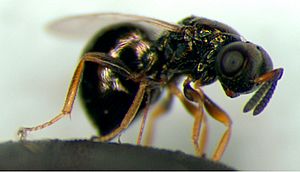Nasonia vitripennis facts for kids
Quick facts for kids Nasonia vitripennis |
|
|---|---|
 |
|
| Nasonia vitripennis female. | |
| Scientific classification | |
| Kingdom: | |
| Phylum: | |
| Class: | |
| Order: | |
| Superfamily: | |
| Family: |
Pteromalidae
|
| Subfamily: |
Pteromalinae
|
| Genus: |
Nasonia
|
| Species: |
N. vitripennis
|
| Binomial name | |
| Nasonia vitripennis |
|
The Nasonia vitripennis is a tiny wasp that is part of a group of four known species in the Nasonia family. These wasps are called parasitoids. This means they lay their eggs inside or on other insects.
Nasonia vitripennis wasps target the larvae (young stage) of flies. These flies, like blowflies and flesh flies, are often found on dead animals. They can also be parasites themselves, harming baby birds in their nests.
Scientists are very interested in these wasps. They are the most studied parasitoid wasps. Learning about them helps us understand the whole group of insects called Hymenoptera, which also includes bees and ants. Because they control other insects, Nasonia vitripennis could be used as a natural way to fight pests, like a biopesticide.
Scientists have studied N. vitripennis to learn how insects make special scents called pheromones. They also study how their sex is decided as they grow. They compare their proteins and genes to other insects, especially the Western honey bee. In 2010, the full genetic map (genome) of N. vitripennis was completed. This has made it much easier to study their genes and learn about their venom and how they smell things.
What Does Nasonia vitripennis Look Like?
Nasonia vitripennis wasps are small, usually about 2 to 3 millimeters long. That's about the size of a few grains of rice! Like other Nasonia wasps, the males and females look different. This is called sexual dimorphism.
Females are usually bigger and darker than males. It's harder to tell different Nasonia species apart by looking at the females. But N. vitripennis females have a straight vein on their front wing, which helps identify them.
Males are easier to tell apart by their antennae and wing shapes. The lower part of a male N. vitripennis's antenna is wider in the middle, like a spindle. Their antennae are also shorter and wider than those of other Nasonia species. Male N. vitripennis also have small front wings compared to their relatives.
How Nasonia Wasps Reproduce
Most Hymenoptera insects, like bees and ants, can reproduce in a special way. Females can lay eggs that are not fertilized by a male. These unfertilized eggs grow into males. This is called parthenogenesis. Fertilized eggs, which have genetic material from both parents, grow into females.
In Nasonia wasps, whether an egg is fertilized or not is the main way its sex is decided. This is different from many other Hymenoptera, like honey bees. Honey bees use a system where a single gene decides sex.
For Nasonia wasps, scientists have a model called Maternal Effect Genomic Imprinting Sex Determination (MEGISD). It's a bit complex, but the main idea is that being female is the default. Males develop because of something passed down from the mother that "silences" the female development process.
The Wolbachia Bacteria
Wolbachia are tiny bacteria that live inside many insects, including Nasonia wasps. These bacteria are passed down from the mother to her offspring. Different types of Wolbachia can even be found in a single group of Nasonia wasps.
Wolbachia are often called endosymbionts, meaning they live inside another organism. They can affect how fertile the wasps are. Scientists think that Wolbachia might help new types of wasps appear faster. This happens by moving genetic material between different groups of wasps.

